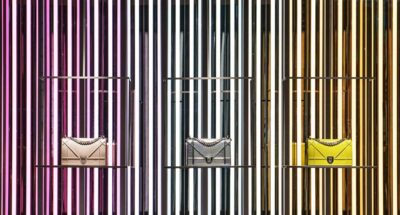
Why future-facing luxury brands must favor excellence over perfection
What does it mean to be excellent, not perfect, in 2024, and why should luxury brands weave the answer into their strategy? ...

by Stéphane J. G. Girod Published 21 April 2021 in Strategy • 5 min read
Luxury is one industry that has a legitimate excuse not to sell online. It represents everything that surrounds differentiation, and is the antithesis of copying others.
However, it has become a non-negotiable for brands to somehow connect consumers’ online and offline journeys. This ability to connect the two journeys is the cornerstone of augmented retail.
“The boundaries between on and offline, but also between the various points of sales with boutiques or watch partners, have faded away and we now have a more cohesive and coherent approach. This is something we had wanted to do for many years,” said Renaud Litré, International Commercial Director at Cartier during the Distribution Panel of Watches and Wonders Geneva earlier this month.
Here are three steps that luxury brands thriving with digitally augmented retail have made to connect consumers’ online and offline journeys.
In the traditional linear retail operating model, assortment selection leads to warehousing and logistics, which then flows into store design and product display. At the end of the line is marketing, selling and customer support.
But the tides have turned and a customer-centric operating model is dominating, with customer-related data usurping product pushing as the essence of every decision taken.
When the customer is at the center, the process stops being linear. Rather than trying to sell a customer a product, you first try to understand her context and pain points. For instance, is she in a hurry? Does she want the full experience? That drives the choice of offering and experience that you choose to propose to that customer at that point in time.
As the pandemic struck, it exposed the fact there were “so many weak retailers that were hanging on by a thread and did not have a connection to the consumer at all,” says Ben Clymer, Founder, Hodinkee, a New York-based e-commerce watch website.
Luxury has traditionally been obsessed with perfection. But, often, the cost of perfection is rigidity.Stéphane J.G. Girod
“Some made it and some didn’t. […] But we are seeing a tightening of the market and that will help people feel closer to their brands.”
The data is to be found online, say, in social media chats, but also in-store. Take Chanel Couture’s experiment. Absent from the online selling space, Chanel has created an experience via an app in which clients have their QR code scanned by salespeople.
At 19 rue Cambon 1, Paris, special mirrors in the dressing rooms are connected with the digital identity of the customer, enabling garments and combinations to be suggested based on tastes and preferences.
Farfetch is reportedly considering offering this “physical cookie” solution to other luxury fashion brands. The more feedback given by clients, the more the technology can be shaped by their idiosyncrasies and the more meaningful in-store interactions can become.
Progressive luxury retailers are swapping their “let’s sell at all costs now” attitude to one that focuses on engaging with the four out of five people who, on average, do not buy at the moment.
They want to understand their customers and convert them later, marking a shift away from today’s transaction towards context-relevant relationships and intelligent conversations.
According to Antonio Carriero, Breitling’s Chief Digital Officer, it all starts by making sure you acquire customer data even if the customer does not buy right away. This might be easier online, but it is all too often overlooked in store.
Data allows you to connect with your customer via newsletters and targeted advertising, and then measure the impact and tailor the approach in a way that sooner or later converts the prospect. With this approach, Breitling has been able to grow its conversion rate of non-buyers to 60%.
Breitling and Van Cleef & Arpels have been growing so fast in the last few years precisely because they have been doggedly building their customer relationship management and databases over time.
Luxury has traditionally been obsessed with perfection. But, often, the cost of perfection is rigidity. Owing to customers’ more complex lifestyles, brands need to be able to adapt more than before.
Building a culture of excellence is, therefore, safer for luxury retailers going forward. And it is defined by empowering frontline employees to adapt whilst still delivering the outstanding experience luxury should be about.
Successful empowerment is based on trust. So how do you achieve that? First, as a leader, you need to create a frame — some general rules within which employees can experiment and adapt. But you must revisit those rules regularly.
Another instance of trust building is expertise. Thus, according to Philippe Tardivel, Hublot’s Marketing Director, brands and retailers alike need to up their game and invest in digital talent acquisition.
And a third lever for the same is to create an organization in which information is shared and there is tight collaboration. Clymer makes the point that content experts need not be sales experts, but that collaboration when necessary between the two got Hodinkee growing.
Adaptability prevails in luxury’s new culture of excellence in a bid to maintain the creation of state-of-the art experiences consistent with luxury, while getting rid of the fear of experimenting and adapting.
It’s a big leadership shift but ultimately it is the only way to attract top talent in the retail arena.
Professor Stéphane J.G. Girod’s forthcoming book, Resetting Management, explores these topics in greater depth and business agility more widely. It is available at Amazon.

Professor of Strategy and Organizational Innovation
Stéphane J.G. Girod is Professor of Strategy and Organizational Innovation at IMD. His research, teaching and consulting interests center around agility at the strategy, organizational and leadership levels in response to disruption. At IMD, he is also Program Director of Reinventing Luxury Lab and Program Co-Director of Leading Digital Execution.

27 March 2024 • by Stéphane J. G. Girod, Roberto Eggs, Rui Meng in Future of Luxury
What does it mean to be excellent, not perfect, in 2024, and why should luxury brands weave the answer into their strategy? ...

17 October 2023 in Future of Luxury
Integrate disruptive technologies into your sustainability strategy and foster collaborations to drive growth and boost brand value in the context of climate change, said Marie-Claire Daveu and Jan Huckfeldt at the second...

10 September 2021 • by Stéphane J. G. Girod in Future of Luxury
The recent explosive growth of the NFT (Non-fungible token) industry has piqued the interest of many luxury players who are making their foray into the world. ...
Explore first person business intelligence from top minds curated for a global executive audience